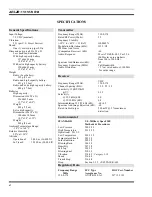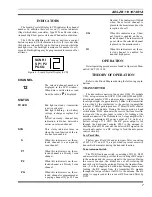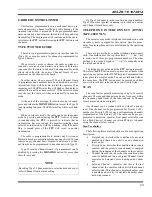
TYPE 99 FORMAT
Tone frequencies in the Ericsson tone system fall within
the range of 517.5 to 997.5 Hz.
In the tone format, the first tone can be from Tone Group
A (for individual or group calls) or from Tone Group C (for
super group calls). The second tone may be from Tone
Group B (for individual calls) or from Tone Group D (for
group or super group calls). The tone format is illustrated as
follows.
INDIVIDUAL
CALL
FORMAT
<...1.0 SEC...>
20%
TONE A
<...200 MS...>
25%
GAP
<..1.0 SEC..>
+300%,-0%
TONE B
GROUP
CALL
FORMAT
<...1.0 SEC...>
20%
TONE A
<...200 MS...>
25%
GAP
<..1.0 SEC..>
+300%, -0%
TONE D
SUPER
GROUP
CALL
FORMAT
<...1.0 SEC...>
20%
TONE C
<...200 MS...>
25%
GAP
<..1.0 SEC..>
+300%, -0%
TONE D
For example, assume the paging number to be 123; the
first digit of the paging number is a "1." Look in Table 3 and
read down the column labeled "100’s Digit" to a "1." Read
horizontally across the column labeled "10’s Digit." The
Tone Group is B. The second digit of the paging number is
a "2." The tone number is B2. Look in Table 4 and down
the column labeled "Tone Designator" to find B2. Read
horizontally across the column labeled "Tone Frequency."
The first tone frequency is 787.5 Hz.
To determine the second tone frequency, look in Table 3
and, as before, find the first digit of the paging number ("1").
The second Tone Group is A. The third digit of the paging
number is a "3" and the Tone Designator is A3. In Table 4,
read down the column labeled "Tone Designator" and find
A3. Read horizontally across the column labeled "Tone
Frequency." The second tone frequency is 802.5 Hz.
For different paging numbers, locate the first digit in the
"100’s Digit" column and determine the tone frequencies as
described in the example.
Tone D is the diagonal tone used (in Ericsson systems
only) when the first and second tone frequencies are the
same. The standard frequency for Tone D is 742.5 Hz, but
may be programmed with any tone frequency.
Table 3 - Ericsson Tone Groups
100’s
Digit
10’s
Digit
For First
Tone
1’s
Digit
For Second
Tone
0
1
2
3
4
5
6
7
8
9
A
B
B
A
C
C
C
A
B
NOT USED
A
A
B
B
C
A
B
C
C
MOTOROLA FORMAT
Tone frequencies in the Motorola tone system are within
the range of 288.5 to 1433.4 Hz. In the Motorola tone
format, the first tone may be one of three tones: A for
Individual Call, B for Quick Call, and C for Group Call. The
second or final tone is B in all cases.
The Motorola tone format is illustrated as follows:
INDIVIDUAL
CALL
FORMAT
<..1.0 SEC..>
(Minimum)
TONE A
<..NONE..>
(Minimum)
GAP
<..3.0 SEC..>
TONE B
GROUP
CALL
FORMAT
<..1.0 SEC..>
(Minimum)
TONE C
<..NONE..>
(Minimum)
GAP
<..3.0 SEC..>
TONE B
SUPER
GROUP
CALL
FORMAT
<..............................8 SEC..............................>
TONE B
Individual Call
Tables 5 and 7 may also be used to determine the tone
frequencies. The first digit of the code determines the tone
group used in the code (see Table 5). Then Table 6 is used
to determine the actual tone frequencies. For a code of 124,
the tone groups used are shown in Table 5. Tone A and Tone
B are both located in Tone Group 1 and Tone B is tone
number 4. Refer to the following examples for additional
information.
The radio is able to recognize the A, B, and C tones.
Individual, Group, and Quick Call formats may be used
simultaneously.
NOTE
AE/LZB 119 1874 R1A
17
Summary of Contents for KPC-300
Page 1: ...ericssonz Maintenance Manual KPC 300 400 Portable Radio ...
Page 8: ...Figure 5 Block Diagram AE LZB 119 1874 R1A 8 ...
Page 29: ...EXPLODEDVIEW EXPLODED VIEWS AE LZB 119 1874 R1A 29 ...
Page 30: ...COMPONENT LAYOUT TOP BOTTOM SUB BOARD AE LZB 119 1874 R1A 30 ...
Page 31: ...COMPONENT LAYOUT MAIN BOARD TOP AE LZB 119 1874 R1A 31 ...
Page 32: ...COMPONENT LAYOUT MAIN BOARD BOTTOM AE LZB 119 1874 R1A 32 ...
















































